Comprehensive Report: Analyzing Cyber Security Threats & Prevention
VerifiedAdded on 2023/06/12
|9
|1902
|143
Report
AI Summary
This report provides an overview of cyber security breaches, focusing on ransomware, phishing, and denial-of-service attacks. For each threat, the report details the attack mechanism, organizational steps to prevent the attack through technical means and awareness programs, and recommendations for companies to improve their security posture. Specific measures include firewall implementation, browser add-ons, strong passwords, regular data backups, spam protection, and employee awareness training. The report concludes by emphasizing the importance of periodic observation, adherence to security protocols, and continuous improvement in security measures to mitigate cyber threats. Desklib offers a wide range of solved assignments and past papers for students.

Running head: CYBER SECURITY BREACHES
CYBER SECURITY BREACHES
Name of the Student:
Name of the University:
Author Note:
CYBER SECURITY BREACHES
Name of the Student:
Name of the University:
Author Note:
Paraphrase This Document
Need a fresh take? Get an instant paraphrase of this document with our AI Paraphraser
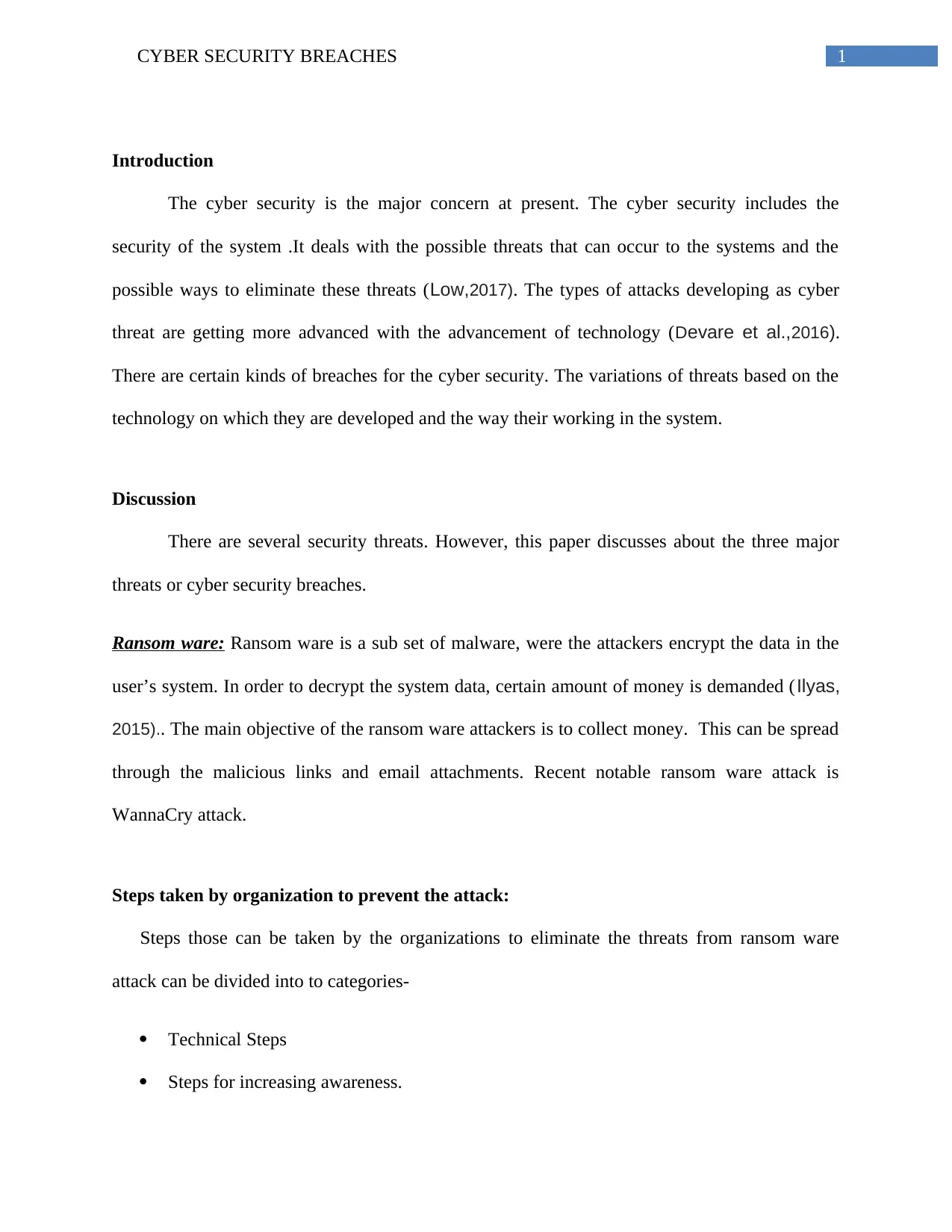
1CYBER SECURITY BREACHES
Introduction
The cyber security is the major concern at present. The cyber security includes the
security of the system .It deals with the possible threats that can occur to the systems and the
possible ways to eliminate these threats (Low,2017). The types of attacks developing as cyber
threat are getting more advanced with the advancement of technology (Devare et al.,2016).
There are certain kinds of breaches for the cyber security. The variations of threats based on the
technology on which they are developed and the way their working in the system.
Discussion
There are several security threats. However, this paper discusses about the three major
threats or cyber security breaches.
Ransom ware: Ransom ware is a sub set of malware, were the attackers encrypt the data in the
user’s system. In order to decrypt the system data, certain amount of money is demanded (Ilyas,
2015).. The main objective of the ransom ware attackers is to collect money. This can be spread
through the malicious links and email attachments. Recent notable ransom ware attack is
WannaCry attack.
Steps taken by organization to prevent the attack:
Steps those can be taken by the organizations to eliminate the threats from ransom ware
attack can be divided into to categories-
Technical Steps
Steps for increasing awareness.
Introduction
The cyber security is the major concern at present. The cyber security includes the
security of the system .It deals with the possible threats that can occur to the systems and the
possible ways to eliminate these threats (Low,2017). The types of attacks developing as cyber
threat are getting more advanced with the advancement of technology (Devare et al.,2016).
There are certain kinds of breaches for the cyber security. The variations of threats based on the
technology on which they are developed and the way their working in the system.
Discussion
There are several security threats. However, this paper discusses about the three major
threats or cyber security breaches.
Ransom ware: Ransom ware is a sub set of malware, were the attackers encrypt the data in the
user’s system. In order to decrypt the system data, certain amount of money is demanded (Ilyas,
2015).. The main objective of the ransom ware attackers is to collect money. This can be spread
through the malicious links and email attachments. Recent notable ransom ware attack is
WannaCry attack.
Steps taken by organization to prevent the attack:
Steps those can be taken by the organizations to eliminate the threats from ransom ware
attack can be divided into to categories-
Technical Steps
Steps for increasing awareness.
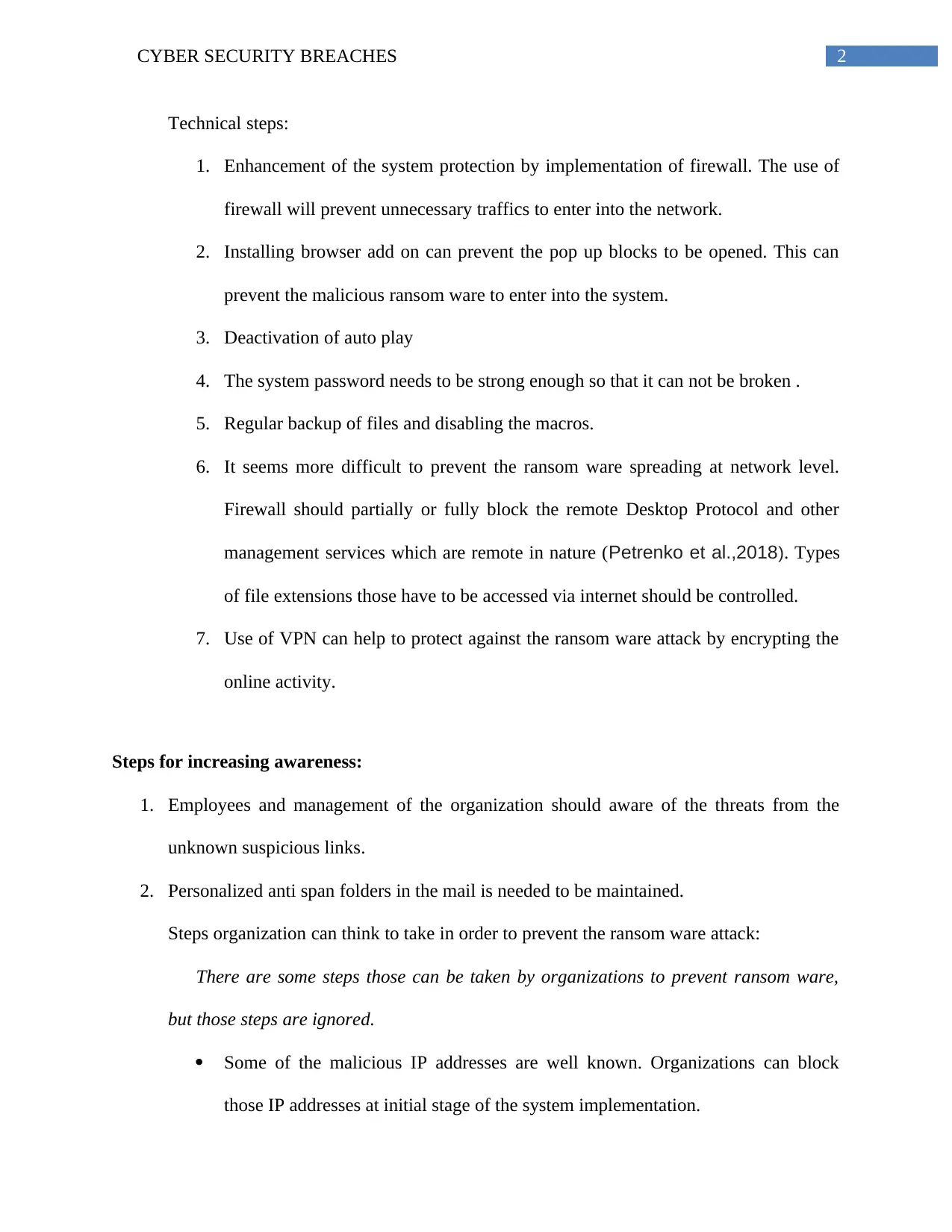
2CYBER SECURITY BREACHES
Technical steps:
1. Enhancement of the system protection by implementation of firewall. The use of
firewall will prevent unnecessary traffics to enter into the network.
2. Installing browser add on can prevent the pop up blocks to be opened. This can
prevent the malicious ransom ware to enter into the system.
3. Deactivation of auto play
4. The system password needs to be strong enough so that it can not be broken .
5. Regular backup of files and disabling the macros.
6. It seems more difficult to prevent the ransom ware spreading at network level.
Firewall should partially or fully block the remote Desktop Protocol and other
management services which are remote in nature (Petrenko et al.,2018). Types
of file extensions those have to be accessed via internet should be controlled.
7. Use of VPN can help to protect against the ransom ware attack by encrypting the
online activity.
Steps for increasing awareness:
1. Employees and management of the organization should aware of the threats from the
unknown suspicious links.
2. Personalized anti span folders in the mail is needed to be maintained.
Steps organization can think to take in order to prevent the ransom ware attack:
There are some steps those can be taken by organizations to prevent ransom ware,
but those steps are ignored.
Some of the malicious IP addresses are well known. Organizations can block
those IP addresses at initial stage of the system implementation.
Technical steps:
1. Enhancement of the system protection by implementation of firewall. The use of
firewall will prevent unnecessary traffics to enter into the network.
2. Installing browser add on can prevent the pop up blocks to be opened. This can
prevent the malicious ransom ware to enter into the system.
3. Deactivation of auto play
4. The system password needs to be strong enough so that it can not be broken .
5. Regular backup of files and disabling the macros.
6. It seems more difficult to prevent the ransom ware spreading at network level.
Firewall should partially or fully block the remote Desktop Protocol and other
management services which are remote in nature (Petrenko et al.,2018). Types
of file extensions those have to be accessed via internet should be controlled.
7. Use of VPN can help to protect against the ransom ware attack by encrypting the
online activity.
Steps for increasing awareness:
1. Employees and management of the organization should aware of the threats from the
unknown suspicious links.
2. Personalized anti span folders in the mail is needed to be maintained.
Steps organization can think to take in order to prevent the ransom ware attack:
There are some steps those can be taken by organizations to prevent ransom ware,
but those steps are ignored.
Some of the malicious IP addresses are well known. Organizations can block
those IP addresses at initial stage of the system implementation.
⊘ This is a preview!⊘
Do you want full access?
Subscribe today to unlock all pages.

Trusted by 1+ million students worldwide
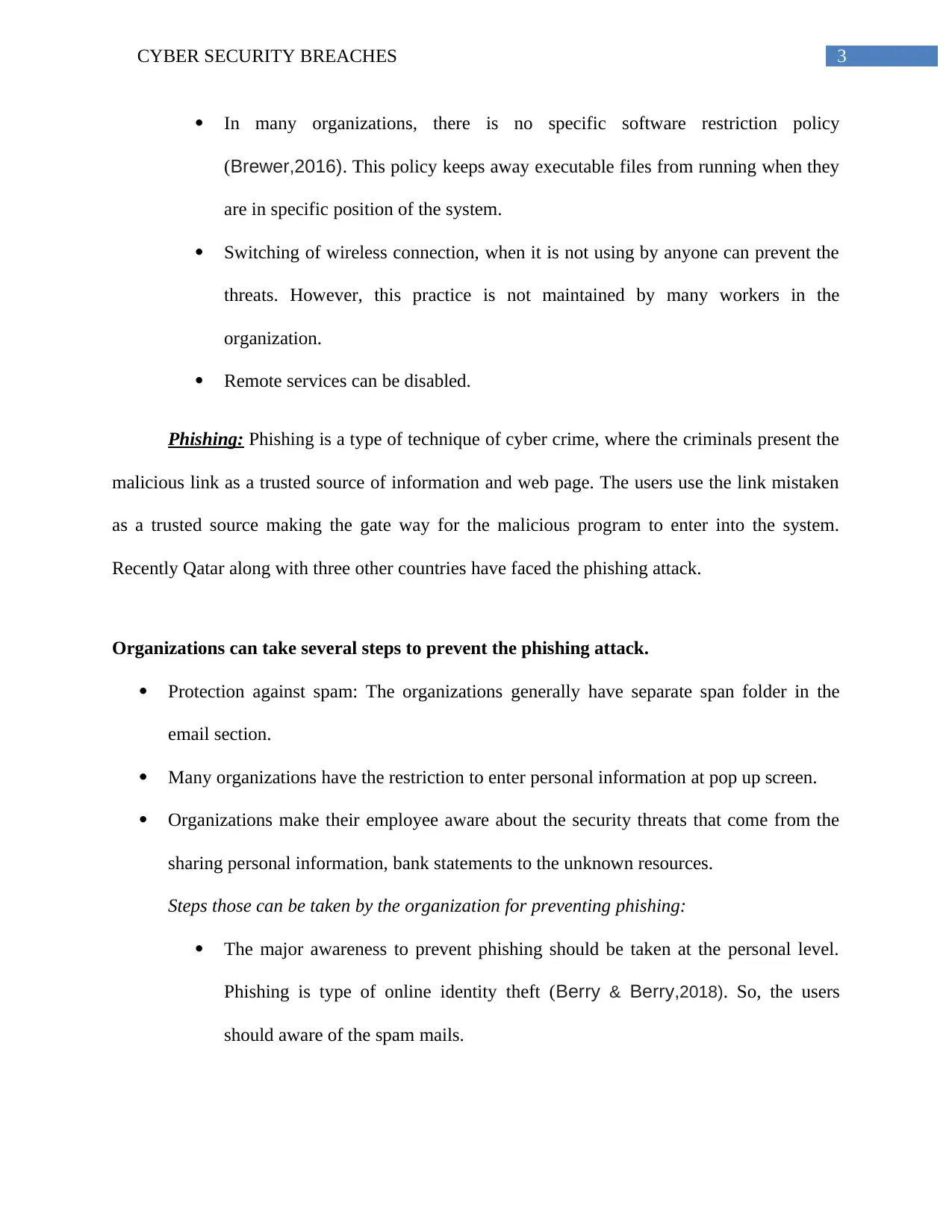
3CYBER SECURITY BREACHES
In many organizations, there is no specific software restriction policy
(Brewer,2016). This policy keeps away executable files from running when they
are in specific position of the system.
Switching of wireless connection, when it is not using by anyone can prevent the
threats. However, this practice is not maintained by many workers in the
organization.
Remote services can be disabled.
Phishing: Phishing is a type of technique of cyber crime, where the criminals present the
malicious link as a trusted source of information and web page. The users use the link mistaken
as a trusted source making the gate way for the malicious program to enter into the system.
Recently Qatar along with three other countries have faced the phishing attack.
Organizations can take several steps to prevent the phishing attack.
Protection against spam: The organizations generally have separate span folder in the
email section.
Many organizations have the restriction to enter personal information at pop up screen.
Organizations make their employee aware about the security threats that come from the
sharing personal information, bank statements to the unknown resources.
Steps those can be taken by the organization for preventing phishing:
The major awareness to prevent phishing should be taken at the personal level.
Phishing is type of online identity theft (Berry & Berry,2018). So, the users
should aware of the spam mails.
In many organizations, there is no specific software restriction policy
(Brewer,2016). This policy keeps away executable files from running when they
are in specific position of the system.
Switching of wireless connection, when it is not using by anyone can prevent the
threats. However, this practice is not maintained by many workers in the
organization.
Remote services can be disabled.
Phishing: Phishing is a type of technique of cyber crime, where the criminals present the
malicious link as a trusted source of information and web page. The users use the link mistaken
as a trusted source making the gate way for the malicious program to enter into the system.
Recently Qatar along with three other countries have faced the phishing attack.
Organizations can take several steps to prevent the phishing attack.
Protection against spam: The organizations generally have separate span folder in the
email section.
Many organizations have the restriction to enter personal information at pop up screen.
Organizations make their employee aware about the security threats that come from the
sharing personal information, bank statements to the unknown resources.
Steps those can be taken by the organization for preventing phishing:
The major awareness to prevent phishing should be taken at the personal level.
Phishing is type of online identity theft (Berry & Berry,2018). So, the users
should aware of the spam mails.
Paraphrase This Document
Need a fresh take? Get an instant paraphrase of this document with our AI Paraphraser
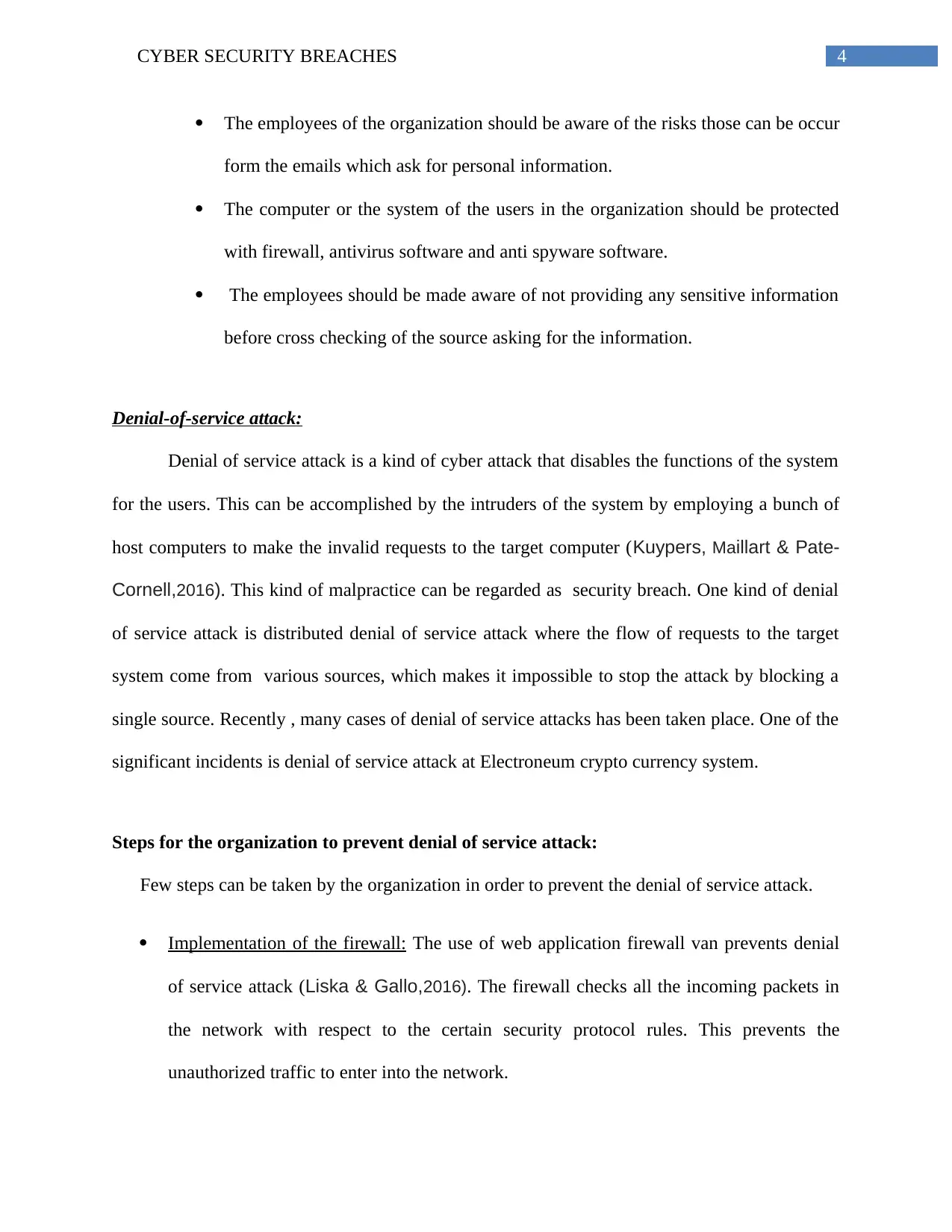
4CYBER SECURITY BREACHES
The employees of the organization should be aware of the risks those can be occur
form the emails which ask for personal information.
The computer or the system of the users in the organization should be protected
with firewall, antivirus software and anti spyware software.
The employees should be made aware of not providing any sensitive information
before cross checking of the source asking for the information.
Denial-of-service attack:
Denial of service attack is a kind of cyber attack that disables the functions of the system
for the users. This can be accomplished by the intruders of the system by employing a bunch of
host computers to make the invalid requests to the target computer (Kuypers, Maillart & Pate-
Cornell,2016). This kind of malpractice can be regarded as security breach. One kind of denial
of service attack is distributed denial of service attack where the flow of requests to the target
system come from various sources, which makes it impossible to stop the attack by blocking a
single source. Recently , many cases of denial of service attacks has been taken place. One of the
significant incidents is denial of service attack at Electroneum crypto currency system.
Steps for the organization to prevent denial of service attack:
Few steps can be taken by the organization in order to prevent the denial of service attack.
Implementation of the firewall: The use of web application firewall van prevents denial
of service attack (Liska & Gallo,2016). The firewall checks all the incoming packets in
the network with respect to the certain security protocol rules. This prevents the
unauthorized traffic to enter into the network.
The employees of the organization should be aware of the risks those can be occur
form the emails which ask for personal information.
The computer or the system of the users in the organization should be protected
with firewall, antivirus software and anti spyware software.
The employees should be made aware of not providing any sensitive information
before cross checking of the source asking for the information.
Denial-of-service attack:
Denial of service attack is a kind of cyber attack that disables the functions of the system
for the users. This can be accomplished by the intruders of the system by employing a bunch of
host computers to make the invalid requests to the target computer (Kuypers, Maillart & Pate-
Cornell,2016). This kind of malpractice can be regarded as security breach. One kind of denial
of service attack is distributed denial of service attack where the flow of requests to the target
system come from various sources, which makes it impossible to stop the attack by blocking a
single source. Recently , many cases of denial of service attacks has been taken place. One of the
significant incidents is denial of service attack at Electroneum crypto currency system.
Steps for the organization to prevent denial of service attack:
Few steps can be taken by the organization in order to prevent the denial of service attack.
Implementation of the firewall: The use of web application firewall van prevents denial
of service attack (Liska & Gallo,2016). The firewall checks all the incoming packets in
the network with respect to the certain security protocol rules. This prevents the
unauthorized traffic to enter into the network.
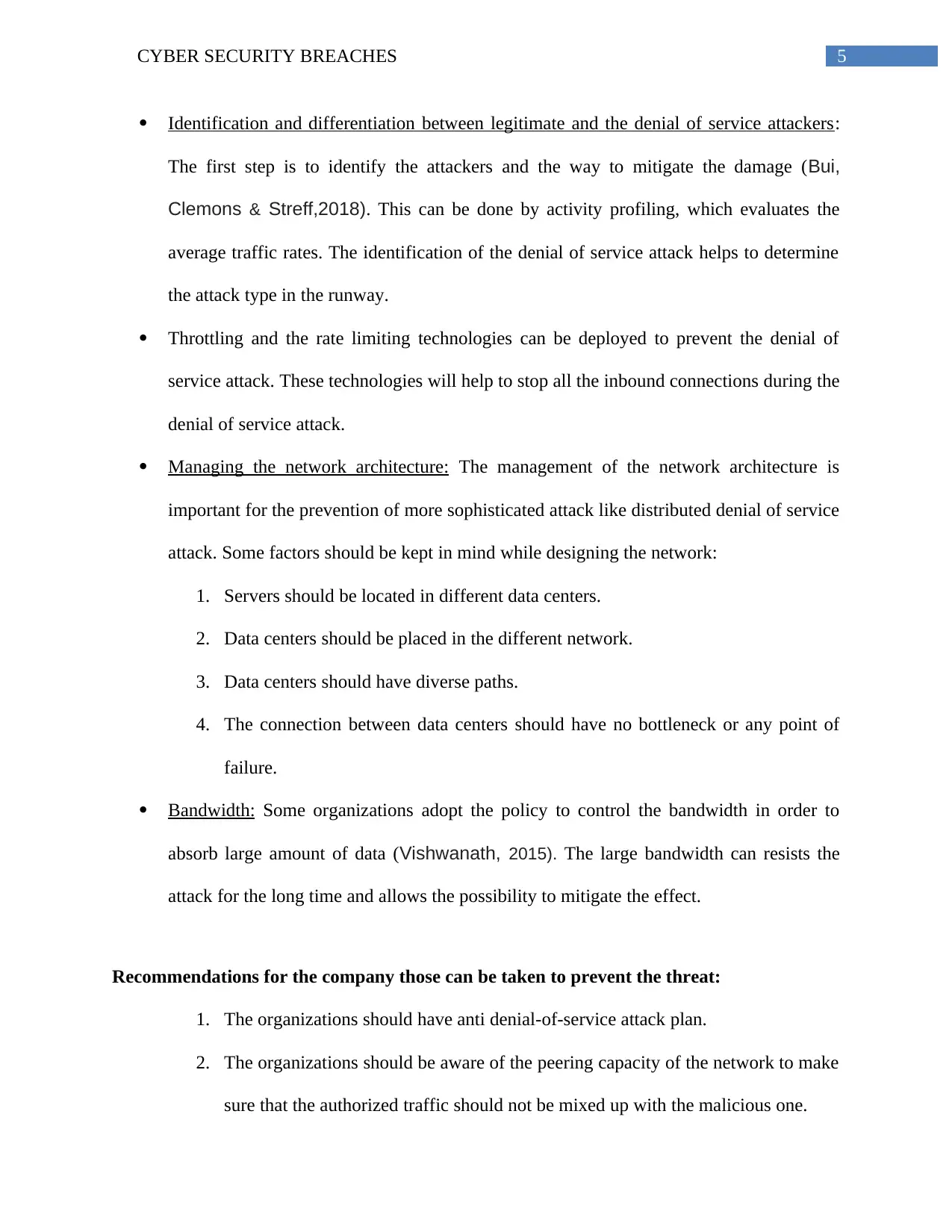
5CYBER SECURITY BREACHES
Identification and differentiation between legitimate and the denial of service attackers:
The first step is to identify the attackers and the way to mitigate the damage (Bui,
Clemons & Streff,2018). This can be done by activity profiling, which evaluates the
average traffic rates. The identification of the denial of service attack helps to determine
the attack type in the runway.
Throttling and the rate limiting technologies can be deployed to prevent the denial of
service attack. These technologies will help to stop all the inbound connections during the
denial of service attack.
Managing the network architecture: The management of the network architecture is
important for the prevention of more sophisticated attack like distributed denial of service
attack. Some factors should be kept in mind while designing the network:
1. Servers should be located in different data centers.
2. Data centers should be placed in the different network.
3. Data centers should have diverse paths.
4. The connection between data centers should have no bottleneck or any point of
failure.
Bandwidth: Some organizations adopt the policy to control the bandwidth in order to
absorb large amount of data (Vishwanath, 2015). The large bandwidth can resists the
attack for the long time and allows the possibility to mitigate the effect.
Recommendations for the company those can be taken to prevent the threat:
1. The organizations should have anti denial-of-service attack plan.
2. The organizations should be aware of the peering capacity of the network to make
sure that the authorized traffic should not be mixed up with the malicious one.
Identification and differentiation between legitimate and the denial of service attackers:
The first step is to identify the attackers and the way to mitigate the damage (Bui,
Clemons & Streff,2018). This can be done by activity profiling, which evaluates the
average traffic rates. The identification of the denial of service attack helps to determine
the attack type in the runway.
Throttling and the rate limiting technologies can be deployed to prevent the denial of
service attack. These technologies will help to stop all the inbound connections during the
denial of service attack.
Managing the network architecture: The management of the network architecture is
important for the prevention of more sophisticated attack like distributed denial of service
attack. Some factors should be kept in mind while designing the network:
1. Servers should be located in different data centers.
2. Data centers should be placed in the different network.
3. Data centers should have diverse paths.
4. The connection between data centers should have no bottleneck or any point of
failure.
Bandwidth: Some organizations adopt the policy to control the bandwidth in order to
absorb large amount of data (Vishwanath, 2015). The large bandwidth can resists the
attack for the long time and allows the possibility to mitigate the effect.
Recommendations for the company those can be taken to prevent the threat:
1. The organizations should have anti denial-of-service attack plan.
2. The organizations should be aware of the peering capacity of the network to make
sure that the authorized traffic should not be mixed up with the malicious one.
⊘ This is a preview!⊘
Do you want full access?
Subscribe today to unlock all pages.

Trusted by 1+ million students worldwide

6CYBER SECURITY BREACHES
3. Companies should divide roles and designations for accessing the networking
devices in the organization.
Conclusion
It can be concluded from the discussion that though there are several threats present for
the system, periodic observation and maintaining certain rules and regulations can help to
prevent the threats. There are some steps those are taken by the most of the organizations for the
protection against threat. However, certain steps can be taken up by organization for further
improvement of the security. These steps have been discussed as the recommendations for the
organization.
References
3. Companies should divide roles and designations for accessing the networking
devices in the organization.
Conclusion
It can be concluded from the discussion that though there are several threats present for
the system, periodic observation and maintaining certain rules and regulations can help to
prevent the threats. There are some steps those are taken by the most of the organizations for the
protection against threat. However, certain steps can be taken up by organization for further
improvement of the security. These steps have been discussed as the recommendations for the
organization.
References
Paraphrase This Document
Need a fresh take? Get an instant paraphrase of this document with our AI Paraphraser
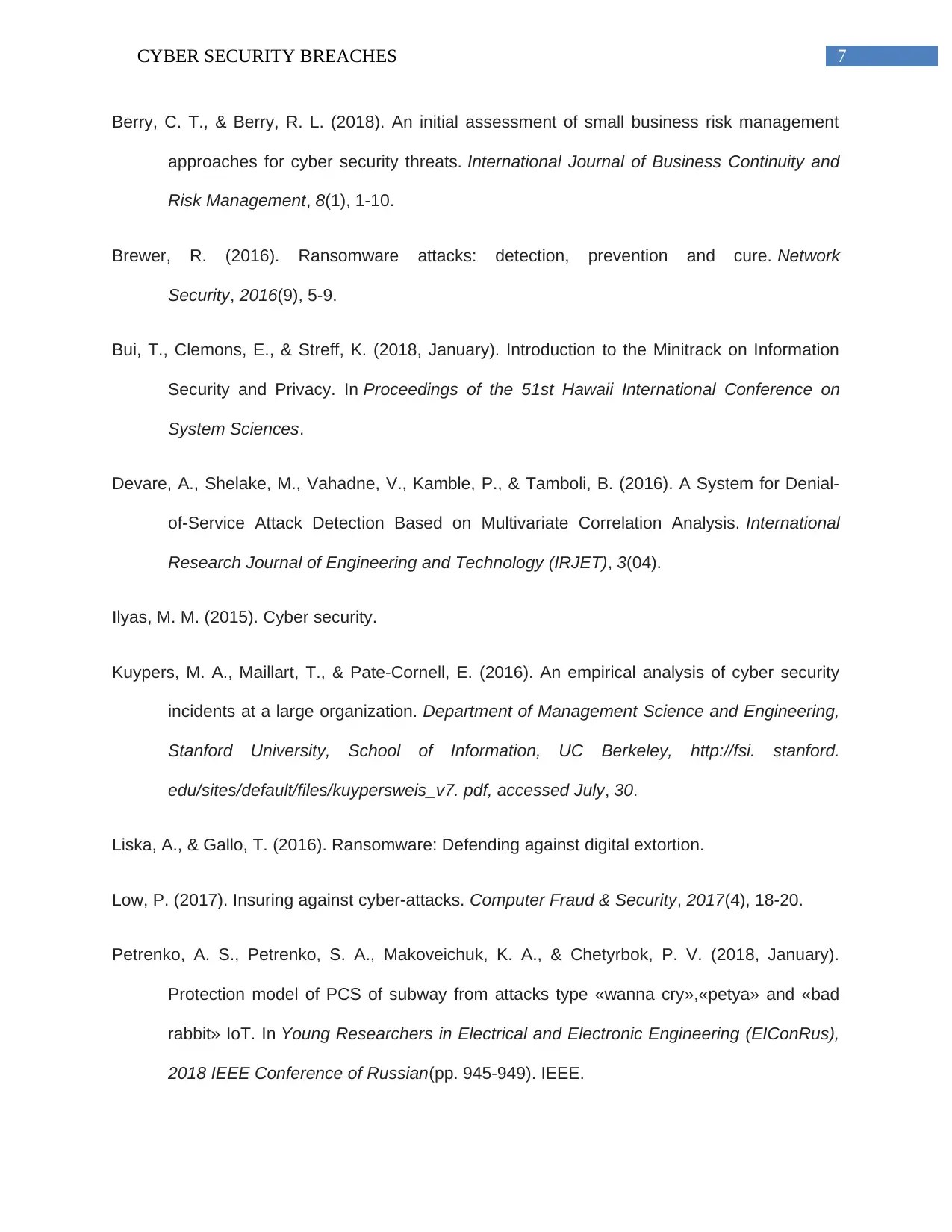
7CYBER SECURITY BREACHES
Berry, C. T., & Berry, R. L. (2018). An initial assessment of small business risk management
approaches for cyber security threats. International Journal of Business Continuity and
Risk Management, 8(1), 1-10.
Brewer, R. (2016). Ransomware attacks: detection, prevention and cure. Network
Security, 2016(9), 5-9.
Bui, T., Clemons, E., & Streff, K. (2018, January). Introduction to the Minitrack on Information
Security and Privacy. In Proceedings of the 51st Hawaii International Conference on
System Sciences.
Devare, A., Shelake, M., Vahadne, V., Kamble, P., & Tamboli, B. (2016). A System for Denial-
of-Service Attack Detection Based on Multivariate Correlation Analysis. International
Research Journal of Engineering and Technology (IRJET), 3(04).
Ilyas, M. M. (2015). Cyber security.
Kuypers, M. A., Maillart, T., & Pate-Cornell, E. (2016). An empirical analysis of cyber security
incidents at a large organization. Department of Management Science and Engineering,
Stanford University, School of Information, UC Berkeley, http://fsi. stanford.
edu/sites/default/files/kuypersweis_v7. pdf, accessed July, 30.
Liska, A., & Gallo, T. (2016). Ransomware: Defending against digital extortion.
Low, P. (2017). Insuring against cyber-attacks. Computer Fraud & Security, 2017(4), 18-20.
Petrenko, A. S., Petrenko, S. A., Makoveichuk, K. A., & Chetyrbok, P. V. (2018, January).
Protection model of PCS of subway from attacks type «wanna cry»,«petya» and «bad
rabbit» IoT. In Young Researchers in Electrical and Electronic Engineering (EIConRus),
2018 IEEE Conference of Russian(pp. 945-949). IEEE.
Berry, C. T., & Berry, R. L. (2018). An initial assessment of small business risk management
approaches for cyber security threats. International Journal of Business Continuity and
Risk Management, 8(1), 1-10.
Brewer, R. (2016). Ransomware attacks: detection, prevention and cure. Network
Security, 2016(9), 5-9.
Bui, T., Clemons, E., & Streff, K. (2018, January). Introduction to the Minitrack on Information
Security and Privacy. In Proceedings of the 51st Hawaii International Conference on
System Sciences.
Devare, A., Shelake, M., Vahadne, V., Kamble, P., & Tamboli, B. (2016). A System for Denial-
of-Service Attack Detection Based on Multivariate Correlation Analysis. International
Research Journal of Engineering and Technology (IRJET), 3(04).
Ilyas, M. M. (2015). Cyber security.
Kuypers, M. A., Maillart, T., & Pate-Cornell, E. (2016). An empirical analysis of cyber security
incidents at a large organization. Department of Management Science and Engineering,
Stanford University, School of Information, UC Berkeley, http://fsi. stanford.
edu/sites/default/files/kuypersweis_v7. pdf, accessed July, 30.
Liska, A., & Gallo, T. (2016). Ransomware: Defending against digital extortion.
Low, P. (2017). Insuring against cyber-attacks. Computer Fraud & Security, 2017(4), 18-20.
Petrenko, A. S., Petrenko, S. A., Makoveichuk, K. A., & Chetyrbok, P. V. (2018, January).
Protection model of PCS of subway from attacks type «wanna cry»,«petya» and «bad
rabbit» IoT. In Young Researchers in Electrical and Electronic Engineering (EIConRus),
2018 IEEE Conference of Russian(pp. 945-949). IEEE.
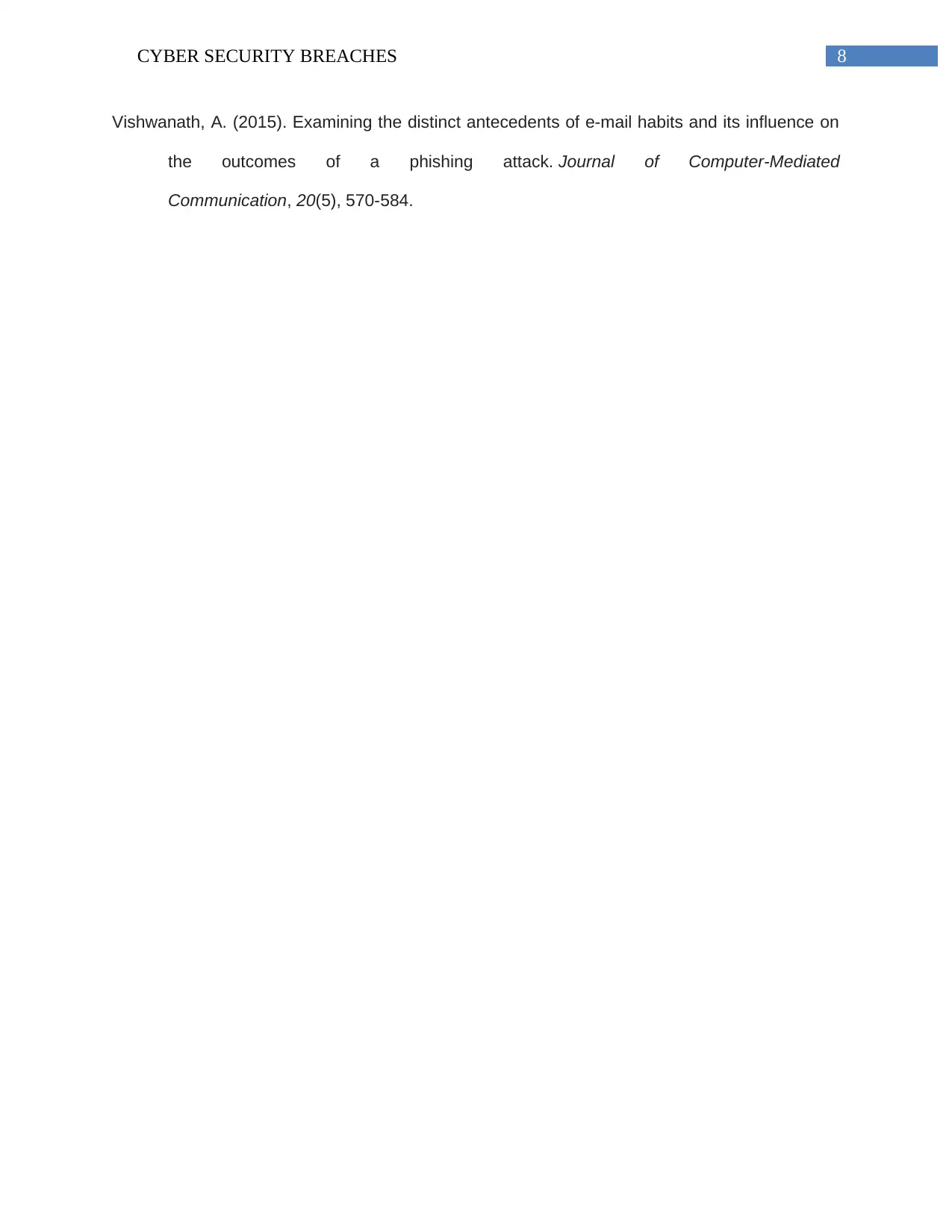
8CYBER SECURITY BREACHES
Vishwanath, A. (2015). Examining the distinct antecedents of e-mail habits and its influence on
the outcomes of a phishing attack. Journal of Computer-Mediated
Communication, 20(5), 570-584.
Vishwanath, A. (2015). Examining the distinct antecedents of e-mail habits and its influence on
the outcomes of a phishing attack. Journal of Computer-Mediated
Communication, 20(5), 570-584.
⊘ This is a preview!⊘
Do you want full access?
Subscribe today to unlock all pages.

Trusted by 1+ million students worldwide
1 out of 9
Related Documents
Your All-in-One AI-Powered Toolkit for Academic Success.
+13062052269
info@desklib.com
Available 24*7 on WhatsApp / Email
![[object Object]](/_next/static/media/star-bottom.7253800d.svg)
Unlock your academic potential
Copyright © 2020–2025 A2Z Services. All Rights Reserved. Developed and managed by ZUCOL.




